The Khamsin Virtual Racecar Challenge (KVRC) is a virtual design competition in which participants design the bodywork of a virtual Formula One racing car in compliance with a subset of current FIA rules. The aerodynamic performance of the design are assessed using Computational Fluid Dynamics to evaluate the proposed design drag, downforce and distribution of forces. The aerodynamic performances are then used in a virtual laptime calculator that uses standardised engine performances and track data to evaluate the lap-time associated with the proposed design. The fastest design wins the race.
Jacopo, an Aerospace Engineering student at Politecnico di Milano, Italy, took part in the KVRC 2013 and 2014 challenge. He won the Magny-Cours race and finished overall second in the KVRC 2014 challenge, which demonstrate his high level of skills in 3D modelling in SketchUp and understanding of vehicle aerodynamic. Now, lets him share some of his design philosophy and practical tips and tools that he refined and used routinely during the challenge.
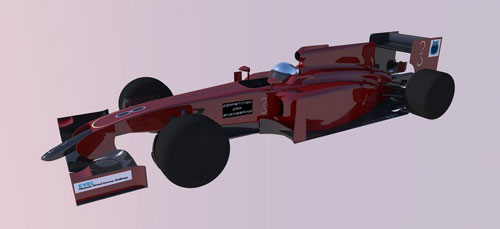
Designing an F1 car using SketchUp (or any other software) is quite a task. Curved surfaces, unusual geometries and functional complexity is what you must deal with as these have a large impact on the overall design perforrmance. Experience using SketchUp and modeling complex curved geometries is of great help, but practice and experimenting with SketchUp make designing a F1 car a job that everybody can do.
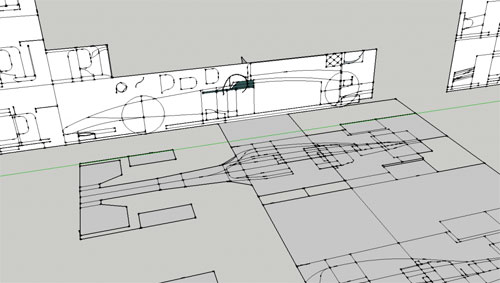
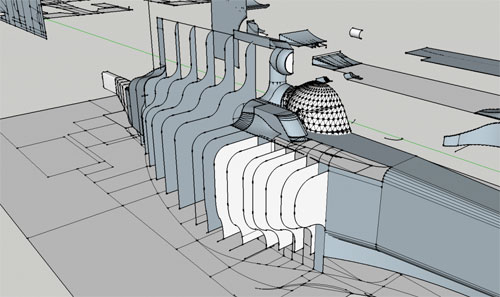
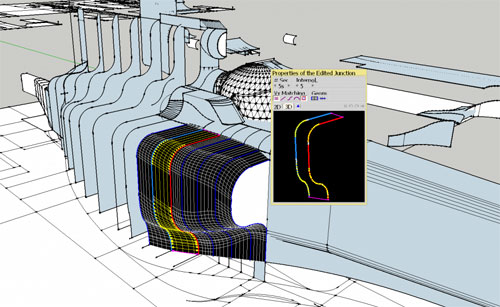
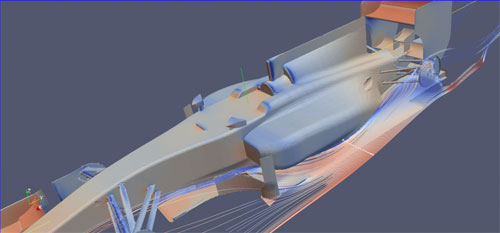
Jacopo, an Aerospace Engineering student at Politecnico di Milano, Italy, took part in the KVRC 2013 and 2014 challenge. He won the Magny-Cours race and finished overall second in the KVRC 2014 challenge, which demonstrate his high level of skills in 3D modelling in SketchUp and understanding of vehicle aerodynamic. Now, lets him share some of his design philosophy and practical tips and tools that he refined and used routinely during the challenge.

First steps
As mentioned before, complexity is one of the main obstacles that any F1 car designer faces. As a first step it is necessary to reduce the system to its basic and schematic components: top and side projections of the car.

This is a key step as it will enable you to foresee tedious geometric problems that you would otherwise detect only once the car is complete. And by then it's too late to fix easily... Nothing else but imagination and experience can help.
Naval techniques
The following step is to convert the 2D projections into a 3D realization of the car, starting with its “skeleton”. The best approach is using cross sections, which is just how it is done with some old school wooden vessel.

When the skeleton is completed, it needs to be covered by the“skin”, which will form the actual car's bodywork. Now, there's a bad way and a good way to do that. The bad one involves constructing the skin by hand, by joining the polygons (i.e. the sections) of the skeleton through triangles. The good one consists in using appropriate plug-in, such as “Curviloft” - my recommendation. This second way allows for a a faster and more detailed skin. It has, however, downsides that I will detail later on.
Some parts of the car, particularly small details, do require the use of more conventional methods, such as combination of extrude tool, and intersect tool...

The model is now pretty much constructed. Still, there are other aspects to take into consideration...
Organising design elements in groups
In order to reduce complexity, it's recommended to build the car part by part . For example, the sidepod part will be constructed separately from the underfloor, the front and rear wings parts, etc... Once each part is constructed, it's a good idea to create a group to store the part geometry by selecting the geometry, and select menu Edit>Create group. Once all parts are constructed, the entire car is assembled by matching the parts.. An advantage of “grouping” parts is that you will be able to easily modify the part itself even after the car is completed without compromising other parts.
Dealing with plug-in(s)
Curviloft is a very useful plugin, but it's more difficult to use properly than it first appear. Problems occur when it is applied to join a long sequence of polygons: it's not rare to observe (small) holes being accidentally created on the surface we want to create. This issue can be either solved manually modifying the conjunction lines between the polygons (a feature that Curviloft itself offers), or designing polygons more “wisely”. This may means\, for example, designing polygons with similar number of segments and comparable geometry, or placing the polygons at a constant distance each other. I also noticed that using more polygons yielded better results.
While it may seem that I am drawing too much attention to surface smoothness and accuracy, these aspects are essential when it comes to meeting competitive requirements for vehicle aerodynamic such as the one required in the CFD based KVRC Challenge. Attention to details was one of the key elements that allowed me to win one of the races and scoring an overall second place during the KVRC 2014 Challenge.

A more technical note
If you intent to construct a model just an aesthetics exercise, you can ignore this last note. But for those who are interested in challenging themselves through a Challenge such as KVRC and trying to emulate F1 engineers, I advise to pay a significant attention to the design of the wings, airfoils, underfloor and diffuser: those are areas where attention to details is a key factor. Keep in mind that you should always relate your SketchUp design work to the settings used in the CFD solver, particularly meshing. If those settings can't realistically capture and model your proposed design details, it's better not to overdesign your car.
Useful Links
KVRC: www.khamsinvirtualracecarchallenge.com
Khamsin, a SketchUp Plugin for CFD Modelling: www.hibouscientificsoftware.com.au
Virtual Stopwatch: www.competition-car-engineering.com
Curviloft: http://sketchucation.com/forums/viewtopic.php?t=28586
Khamsin, a SketchUp Plugin for CFD Modelling: www.hibouscientificsoftware.com.au
Virtual Stopwatch: www.competition-car-engineering.com
Curviloft: http://sketchucation.com/forums/viewtopic.php?t=28586
~~~~~~~~~~~~~~~~~~~~~~~
Published By
Rajib Dey
~~~~~~~~~~~~~~~~~~~~~~~
No comments:
Post a Comment